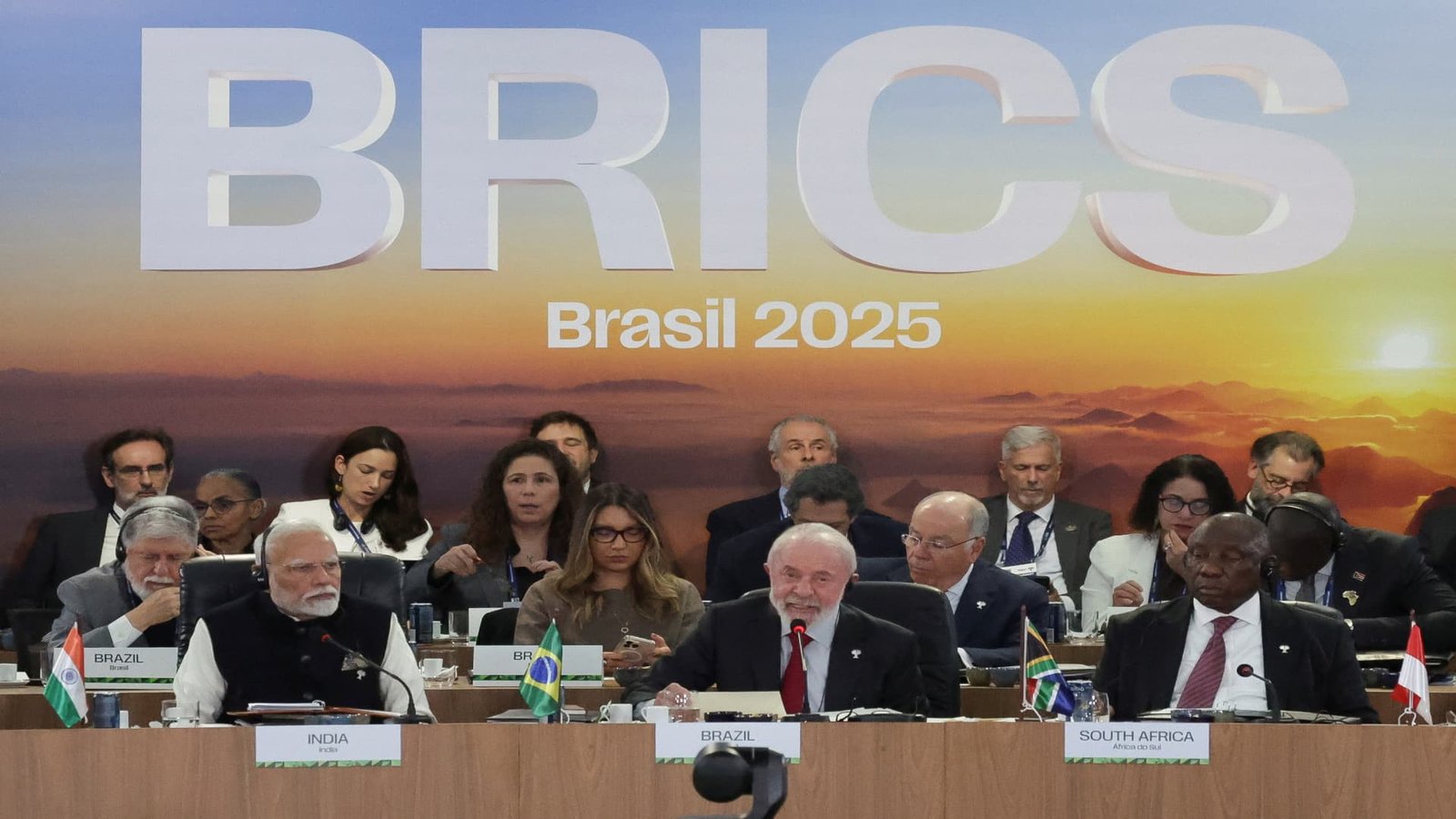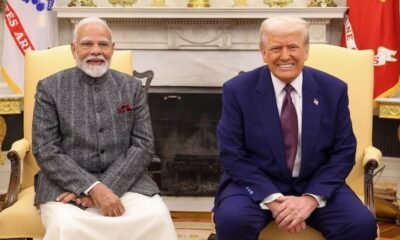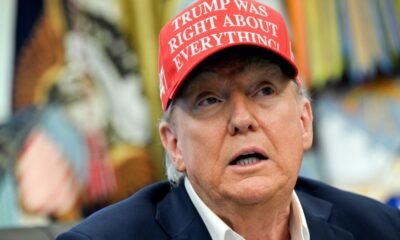Top Stories
BRICS summit Brazil 2025

Brazil’s President Luiz Inacio Lula da Silva speaks during the BRICS Summit, at the Museum of Modern Art in Rio de Janeiro, Brazil, on July 6, 2025.
Ricardo Moraes | Reuters
The BRICS bloc of developing nations on Sunday condemned the increase in tariffs and attacks on Iran, but refrained from naming U.S. President Donald Trump. The group’s declaration, which also took aim at Israel’s military actions in the Middle East, also spared its member Russia from criticism and mentioned war-torn Ukraine just once.
The two-day summit was marked by the absence of two of its most powerful members. China’s President Xi Jinping did not attend a BRICS summit for the first time since he became his country’s leader in 2012. Russian President Vladimir Putin, who spoke via videoconference, continues to mostly avoid traveling abroad due to an international arrest warrant issued after Russia invaded Ukraine.
In an indirect swipe at the U.S., the group’s declaration raised “serious concerns” about the rise of tariffs which it said were “inconsistent with WTO (World Trade Organization) rules.” The BRICS added that those restrictions “threaten to reduce global trade, disrupt global supply chains, and introduce uncertainty.”
Brazil’s President Luiz Inácio Lula da Silva, who hosted the summit, criticized NATO’s decision to hike military spending by 5% of GDP annually by 2035. That sentiment was later echoed in the group’s declaration.
“It is always easier to invest in war than in peace,” Lula said at the opening of the summit, which is scheduled to continue on Monday.
Iran in attendance
Iranian President Masoud Pezeshkian, who was expected to attend the summit before the attacks on his country in June, sent his foreign minister, Abbas Araghchi, to the meeting in Rio.
The group’s declaration criticized the attacks on Iran without mentioning the U.S. or Israel, the two nations that conducted them.
In his speech, Araghchi informed leaders that he had advocated for every member of the United Nations to strongly condemn Israel. He added Israel and the U.S. should be accountable for rights violations. The Iranian foreign minister said the aftermath of the war “will not be limited” to one country.
“The entire region and beyond will be damaged,” Araghchi said.
BRICS leaders expressed “grave concern” for the humanitarian situation in Gaza, called for the release of all hostages, a return to the negotiating table and reaffirmed their commitment to the two-state solution.
Later, Iran’s Araghchi stated in a separate message on the messaging app Telegram that his government had expressed reservations regarding a two-state solution in a note, saying it would not work “just as it has not worked in the past.”
Also on Telegram, Russia’s foreign ministry in another statement named the U.S. and Israel, and condemned the “unprovoked military strikes” against Iran.
Russian President Vladimir Putin participates in the BRICS Summit, held in Rio de Janeiro, Brazil, via videolink from Moscow, Russia, on July 6, 2025.
Mikhail Metzel | Via Reuters
Russia spared
The group’s 31-page declaration mentions Ukraine just once, while condemning “in the strongest terms” recent Ukrainian attacks on Russia.
“We recall our national positions concerning the conflict in Ukraine as expressed in the appropriate fora, including the U.N. Security Council and the U.N. General Assembly,” the group said.
João Alfredo Nyegray, an international business and geopolitics professor at the Pontifical Catholic University in Parana, said the summit could have played a role in showing an alternative to an unstable world, but it won’t do so.
“The withdrawal of Egypt’s President Abdel Fattah al-Sisi and the uncertainty about the level of representation for countries like Iran, Saudi Arabia and the UAE are confirming the difficulty for the BRICS to establish themselves as a cohesive pole of global leadership,” Nyegray said. “This moment demands high-level articulation, but we are actually seeing dispersion.”
Avoid Trump’s tariffs
While Lula advocated on Sunday for reforming Western-led global institutions, Brazil sought to avoid becoming a target of higher tariffs.
Trump has threatened to impose 100% tariffs against the bloc if it takes any steps to undermine the dollar. Last year, at the summit hosted by Russia in Kazan, the Kremlin sought to develop alternatives to U.S.-dominated payment systems, which would allow it to dodge Western sanctions imposed after Russia’s invasion of Ukraine in February 2022
Brazil decided to focus on less controversial issues in the summit, such as promoting trade relations between members and global health, after Trump returned to the White House, said Ana Garcia, a professor at the Rio de Janeiro Federal Rural University.
“Brazil wants the least amount of damage possible and to avoid drawing the attention of the Trump administration to prevent any type of risk to the Brazilian economy,” Garcia said.
‘Best opportunity for emerging countries’
BRICS was founded by Brazil, Russia, India, China and South Africa, but the group last year expanded to include Indonesia, Iran, Egypt, Ethiopia, and the United Arab Emirates.
As well as new members, the bloc has 10 strategic partner countries, a category created at last year’s summit that includes Belarus, Cuba and Vietnam.
That rapid expansion led Brazil to put housekeeping issues — officially termed institutional development — on the agenda to better integrate new members and boost internal cohesion.
Despite notable absences, the summit is important for attendees, especially in the context of instability provoked by Trump’s tariff wars, said Bruce Scheidl, a researcher at the University of Sao Paulo’s BRICS study group.
“The summit offers the best opportunity for emerging countries to respond, in the sense of seeking alternatives and diversifying their economic partnerships,” Scheidl said.
Earlier on Sunday, a pro-Israel non-profit placed dozens of rainbow flags on Ipanema beach to protest Iran’s policies regarding LGBT+ people. On Saturday, human rights group Amnesty International protested Brazil’s plans for offshore oil drilling near the mouth of the Amazon River.
For Lula, the summit is a welcome pause from a difficult domestic scenario, marked by a drop in popularity and conflict with Congress.
The meeting was also an opportunity to advance climate negotiations and commitments on protecting the environment before November’s COP 30 climate talks in the Amazonian city of Belem.
Top Stories
Florida State 31-17 Alabama (Aug 30, 2025) Game Recap

TALLAHASSEE, Fla. — — New quarterback Tommy Castellanos led a punishing rushing attack for Florida State with 78 yards and a touchdown as the Seminoles stunned No. 8 Alabama 31-17 on Saturday, ending the Crimson Tide’s streak of 23 straight wins in season openers.
Coming off a 2-10 season, Florida State handed a crushing setback to Alabama, which was viewed as a College Football Playoff contender under second-year coach Kalen DeBoer.
Students and fans swarmed the field at Doak Campbell Stadium to celebrate the upset by the Seminoles, who were 13 1/2-point underdogs according to Sportsbook.
Under new offensive coordinator Gus Malzahn — who spent eight seasons as Auburn’s head coach — Florida State was physical from the start, finishing with 230 rushing yards and averaging 4.7 yards per carry. The Seminoles averaged just 89.9 yards during their disastrous 2024 season.
The Crimson Tide had not dropped a season opener since losing 20-17 to UCLA in 2001 under Dennis Franchione, and this defeat will ratchet up the pressure on DeBoer from the demanding Tuscaloosa faithful. His predecessor, Nick Saban, led Alabama to six national titles.
DeBoer fell to 6-4 against unranked teams at Alabama; Saban went 124-4 in such games.
Alabama couldn’t solve Florida State’s defense, finishing with 87 rushing yards on 29 carries. Florida State halted Alabama three times on fourth down, the final time coming with 5:39 to go.
Castellanos, a Boston College transfer, had 16 carries while no one else had more than seven rushing attempts for the Seminoles. He also completed 9 of 14 passes for 152 yards as Florida State defeated its first ranked opponent since knocking off No. 19 Louisville in the 2023 Atlantic Coast Conference championship game.
Micahi Danzy, Caziah Holmes and Gavin Sawchuk also had rushing touchdowns for Florida State.
Ty Simpson completed 23 of 43 passes for 254 yards and two touchdowns in his Alabama debut. Germie Bernard led Alabama with eight catches for 146 yards.
Alabama: The Crimson Tide scored on an opening drive that went 8 minutes, 50 seconds, but struggled to sustain drives the rest of the afternoon.
Florida State: The Seminoles bounced back on a big stage as coach Mike Norvell began his sixth season by picking up a fifth win over a Southeastern Conference team.
Alabama hosts Louisiana-Monroe next Saturday.
Florida State hosts East Texas A&M next Saturday.
——
Get poll alerts and updates on the AP Top 25 throughout the season. Sign up here. AP college football: https://apnews.com/hub/ap-top-25-college-football-poll and https://apnews.com/hub/college-football
Top Stories
Alabama vs. Florida State live updates: Crimson Tide, Seminoles battle in clash of marquee brands

One of the biggest nonconference clashes of Week 1 features No. 8 Alabama making its first-ever trip to Tallahassee, Florida, squaring off against a Florida State team that is looking to erase the disappointment of 2024 with a strong performance from a retooled Seminoles roster.
Alabama enters the 2025 with its own bounce-back motivations after last year’s 9-4 finish fell short of expectations for Year 1 under Kalen DeBoer. After inheriting Nick Saban’s program, DeBoer fell just short of the 12-team College Football Playoff in part because of multiple losses as a double-digit favorite. That’s the same favorite status the Crimson Tide carry into this season-opening road tilt, providing a great opportunity for Alabama to start its playoff march by reversing that trend.
For Florida State, there’s a lot at stake in terms of proving that last season’s stunning collapse was just a blip on the radar. After going 13-1 in 2023, Mike Norvell’s team started the season in the top 10 and proceeded to go 2-10. Norvell made new hires at offensive coordinator (Gus Malzahn) and defensive coordinator (Tony White) and brings in a host of transfer talent, including quarterback Tommy Castellanos, to try and flip the script and get the program back on track.
It’s a huge statement spot for both teams in what should be an electric environment in a renovated Doak Campbell Stadium.
Keep it locked here as CBS Sports provides you with live updates, highlights and analysis as Alabama battles Florida State to open the 2025 season in Week 1.
Top Stories
Everyone’s got a theory on Taylor Swift’s engagement – even JD Vance | Arwa Mahdawi

The secret meanings behind Taylor Swift’s engagement
Breaking news alerts were pinged to phones around the world; Swifties screamed in the street; the Prince and Princess of Wales delivered their royal approval; Donald Trump wished them luck. By now it will not have escaped your attention that Taylor Swift, the reigning queen of pop, is engaged to Travis Kelce, a podcaster who also plays football.
What does this engagement mean? It’s possible you naively think it simply means an extremely famous woman and a somewhat famous man enjoy each other’s company and want to settle down together to start a big, beautiful brand partnership. Wrong! When it comes to Swift, Occam’s razor rarely applies. The megastar is known for hiding Easter eggs and hidden meaning in her musical output; she has driven a lot of otherwise normal people on quixotic missions into the deep, dark depths of her lyrics to validate their left-field theories about their idol.
Who can forget, for example, the 5,000-word essay published in the New York Times last year arguing that Swift is secretly part of the LGBTQ+ community and communicating that fact via coded lyrics? A surprisingly large number of “Gaylors” seem invested in this theory: a Gaylor subreddit has more than 50,000 members. Following news of the proposal, it went private to avoid trolling from outsiders.
While the engagement has sent some Gaylors into mourning, various conservatives are celebrating the idea that Swift might be on her way from being an independent career woman to a tradwife. On his podcast, the rightwing activist Charlie Kirk mused that getting married and having kids changes a person, and he hopes that it will “deradicalize” the billionaire – who is, it must be said, not widely known for having any radical ideas.
“Taylor Swift might go from a cat lady to a JD Vance supporter,” Kirk said. “I think that if she ends up having children, she’ll stop this kind of liberal endorsing Joe Biden nonsense.” (Well, I mean, she’s not going to be endorsing Biden any more, that’s for sure.) Kirk added: “Reject feminism. Submit to your husband, Taylor. You’re not in charge.” Oh, I think she is.
While Vance himself hasn’t weighed in on whether he thinks the Kelce effect will mean Swift suddenly has a Mar-a-Lago makeover and starts fangirling over Maga politics, he has aired his thoughts on the news. More specifically, he used the Swift-Kelce engagement to float the conspiracy theory that NFL games could be rigged for Kelce’s team, the Chiefs. “I hope that the NFL does not put a thumb on the scale for the Kansas City Chiefs just because Travis Kelce is now getting married to maybe the most famous woman in the world,” Vance told USA Today in an interview on Wednesday.
It’s not just the right projecting their hopes, dreams and weird Super Bowl fantasies on to Kelce-Swift. Some Swifties have been gushing over what a great guy Kelce is because “he has no issue with Swift being successful”. While Kelce may well be supportive of his megastar fiancee, let’s not get carried away and frame him as some sort of feminist. The football star has called women “breeders” in the past and defended his Kansas City Chiefs teammate Harrison Butker after Butker delivered a bigoted commencement speech last year, calling Pride month a “deadly sin” and telling women they should be more excited about getting married and having kids than having a successful career. Kelce made clear that he doesn’t agree with the majority of Butker’s views, but said it wasn’t his place to criticize them. Kind of a slap in the face to all of Swift’s queer fans for her husband-to-be to let the Pride comments slide, just because Butker has always been nice to him.
Various other hot takes about the engagement abound. The business press have been talking about how the engagement might boost stocks and marketing trade journals have been looking at brand reactions. No doubt even defence industry publications (which have previously put out bangers like What Travis Kelce and Taylor Swift Can Teach Veterans About Federal Resumes) will find an angle.
If you can’t beat them, join them: since it’s the Swift Hot Take Super Bowl, I’ll quickly get mine in. I think the singer is very talented, and I’m glad she makes a lot of people very happy, but I do wish she would do a Ms Rachel and use her unmatched influence to shame politicians into action on Gaza. Or at least follow the lead of the YouTuber Lindsay Ellis and raise money for suffering kids. Parents are having to watch their children wither away amid a man-made famine facilitated (and denied) by the US. Doctors are coming back from Gaza with harrowing stories about Israeli soldiers targeting kids with shots to the head and deliberately shooting teenage boys in the testicles. You can argue all day about whether celebrities have an obligation to speak out about injustice or not but, ultimately, having so much influence and choosing not to use it in the face of a genocide your government is helping to perpetuate, and your engagement knocks from the front page, is not “neutrality”. It is a deliberate choice.
Amnesty calls for end of investigation into Polish doctor who performed abortion
Last year, Dr Gizela Jagielska was targeted by anti-abortion extremists after she provided a legal late-term abortion to a woman in a hospital in southern Poland after her unborn baby was diagnosed with a fatal foetal anomaly. Poland has some of the most restrictive abortion laws in Europe. Jagielska is being investigated by authorities and faces possible imprisonment of up to eight years. “Instead of investigating Dr Jagielska’s conduct, the Polish authorities must look into the attacks she has faced since the investigation was announced,” Amnesty International said in a statement this week.
Now I ain’t saying she’s a gold digger … but she is trademarking the term
What first attracted the 24-year-old former cheerleader Jordon Hudson to the 73-year-old multimillionaire Bill Belichick, I wonder? We may never know. But do we know that Hudson’s company has filed a trademark application for the term “gold digger”, to be used on jewellery or keychains. Instead of getting huffy about the jokes about her being attracted to Belichick’s big bank account, she’s monetizing them.
Italian police investigating porn site with doctored pictures of prominent women
If you are a woman in the public eye, it’s almost inevitable that insecure men will use technology to humiliate you online. And the tech bros who keep telling us AI will revolutionize the world seem helpless (or just not interested) when it comes to stopping it.
Snoop Dogg is ‘scared to go to the movies’ because of animated lesbians
The musician has called himself a “gangsta” but he’s apparently terrified of two fictional women parenting a child together. Snoop told a podcast he was horrified when he took his grandson to see Pixar’s Lightyear and the child asked about the two gay mums in the movie. Instead of just answering his grandson’s question like a normal person, Snoop clutched his pearls.
Denmark apologises for forced contraception of Greenlandic women
It’s estimated that 4,500 women and girls were fitted with contraceptive coils without their permission or knowledge in the 1960s in an attempt to reduce the population of Greenland.
UK gender pay gap underestimated for two decades, report says
The faulty methodology, which gave undue weight to large companies, resulted in an underestimate of a “small but noteworthy” margin of one percentage point, new research says.
Fertility rate hits record low in England, Scotland and Wales
And we will continue to see headlines like this until the cost of living goes down (or wages rise in response) and having children becomes more affordable.
Grammy-award winning singer Tems is helping African women navigate music industry
The Nigerian singer-songwriter and producer, born Temilade Openiyi, has launched the Leading Vibe Initiative to try to help more young women in Africa overcome the hurdles of breaking into the music industry.
How an oil spill in Mauritius led to a female revolution in farming
After a wrecked ship polluted the water and sank the local economy, a group of women formed the South-East Ladies Agro collective and started “bringing home the bok choi”.
The week in pawtriarchy
In the Guardian, Frances Ryan considers the impaw-tant question: is it wrong to throw a birthday party for my dog? The short answer is: absolutely not, your pooch would be barking mad if you didn’t.
-
Tools & Platforms3 weeks ago
Building Trust in Military AI Starts with Opening the Black Box – War on the Rocks
-

 Ethics & Policy1 month ago
Ethics & Policy1 month agoSDAIA Supports Saudi Arabia’s Leadership in Shaping Global AI Ethics, Policy, and Research – وكالة الأنباء السعودية
-

 Events & Conferences3 months ago
Events & Conferences3 months agoJourney to 1000 models: Scaling Instagram’s recommendation system
-

 Jobs & Careers2 months ago
Jobs & Careers2 months agoMumbai-based Perplexity Alternative Has 60k+ Users Without Funding
-

 Funding & Business2 months ago
Funding & Business2 months agoKayak and Expedia race to build AI travel agents that turn social posts into itineraries
-

 Business1 day ago
Business1 day agoThe Guardian view on Trump and the Fed: independence is no substitute for accountability | Editorial
-

 Education2 months ago
Education2 months agoVEX Robotics launches AI-powered classroom robotics system
-

 Podcasts & Talks2 months ago
Podcasts & Talks2 months agoHappy 4th of July! 🎆 Made with Veo 3 in Gemini
-

 Podcasts & Talks2 months ago
Podcasts & Talks2 months agoOpenAI 🤝 @teamganassi
-

 Jobs & Careers2 months ago
Jobs & Careers2 months agoAstrophel Aerospace Raises ₹6.84 Crore to Build Reusable Launch Vehicle





















